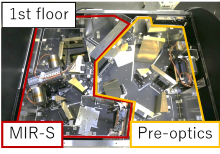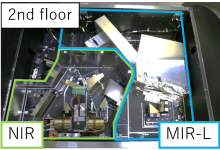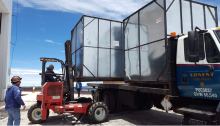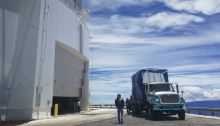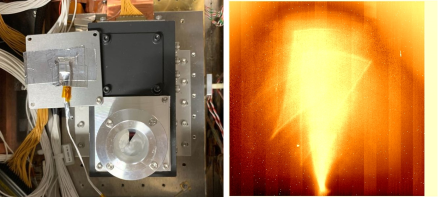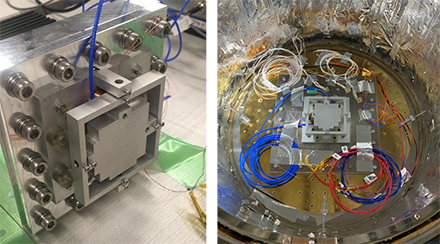
|
TAO Project |
|
The TAO project

|
MIMIZUKU: Preparing in Japan for Full-Scale ObservationsMIMIZUKU, the mid-infrared instrument for the TAO 6.5m telescope has made its commissioning observation on the Subaru Telescope of NAOJ in Hawaii in 2018 (see here for more details). It was MIMIZUKU's first light, the initial observation of celestial bodies, and one of the milestones of our development. However, the only optical system that had completed development at that time was MIR-S (fig. 1), which observes mid-infrared light at wavelengths of 7-26 microns. In addition to the MIR-S channel, MIMIZUKU is equipped with two other optical channels, NIR for near-infrared (2-6 microns in wavelength) and MIR-L for long-wavelength mid-infrared (24-38 microns in wavelength). The completion of these channels will realize the wide wavelength coverage that is a feature of MIMIZUKU. This functionality will allow us to observe infrared radiation emitted from materials of various temperatures, from high-temperature objects such as stars (several thousand degrees Celsius), to solid particles (dust; about -200 to 1000 degrees Celsius) in their surroundings, with a single instrument. This will enable observational studies of time-varying phenomena such as dust formation and growth processes and planet formation processes, which are the goals of MIMIZUKU. Therefore, it is important for us to complete the development of the remaining NIR and MIR-L channels.
As of 2018, MIMIZUKU was situated in Hawaii. It was difficult for us to continue the development work there, and we also wanted to avoid bothering Subaru staff, who were extremely busy accepting new instruments. On the other hand, it will take some time until the completion of the TAO base experiment building. So we have decided to transport MIMIZUKU to Japan and resume development work at the IoA in Mitaka, Tokyo. In June 2019, we transported MIMIZUKU from the summit of Maunakea, where the Subaru Telescope is located, to the Hilo base (fig. 2), and in October 2019, we shipped it to Japan. Finally, MIMIZUKU arrived in Mitaka on December 26, 2019 (fig. 3). Many people have helped us in the series of work, including the staff of Subaru Telescope, graduate students (Mr. Tachibana, Mr. Beniyama, and Mr. Kushibiki), and Dr. Uchiyama, an alumnus of the MIMIZUKU development team. We would like to express our gratitude to them.
While the optics for the NIR and MIR-L channels have already been completed, we need to develop a control system for the onboard detector. We are currently developing a control system for the semiconductor detector to be installed in the NIR channel. This system was once installed on MIMIZUKU in the past development and successfully obtained images. But we found problems, such as unexpected small responsivity and fluctuations in output signal. We decided to suspend our installation work for the time being. We have reviewed the control system and detector drive method, and are working the problems step by step (fig. 4). As soon as the problems are solved, the system will be mounted on MIMIZUKU again, and the development of the NIR channel will be completed soon. Afterwards we will start developing another control system for the detector of the MIR-L channel. Another important item is a cold chopper (fig. 5). This is a mechanical system to be installed in the cold optics (about -250 degrees Celsius) to switch the optical path by moving the mirror rapidly (rectangular motion of one second per round trip). By using this mirror motion to shift the position of the object in the image and subtracting the data, we can extract the infrared light of an object buried in the vast amounts of infrared radiation from the atmosphere and the telescope. So this cold chopper system is crucial for MIMIZUKU observations. We are currently proceeding the development with Prof. Honda at Okayama University of Science and Prof. Jikuya in Kanazawa University, and have succeeded to realize the required rapid motion at room temperature. The next step is to test the performance under cryogenic conditions similar to those inside MIMIZUKU, and this is in progress at the IoA. We will implement this system to MIMIZUKU as soon as the test and adjustment are completed.
Copyright(c) 2007-2018 TAO Project, Institute of Astronomy, Graduate School of Science, University of Tokyo
|
||||||||||||
